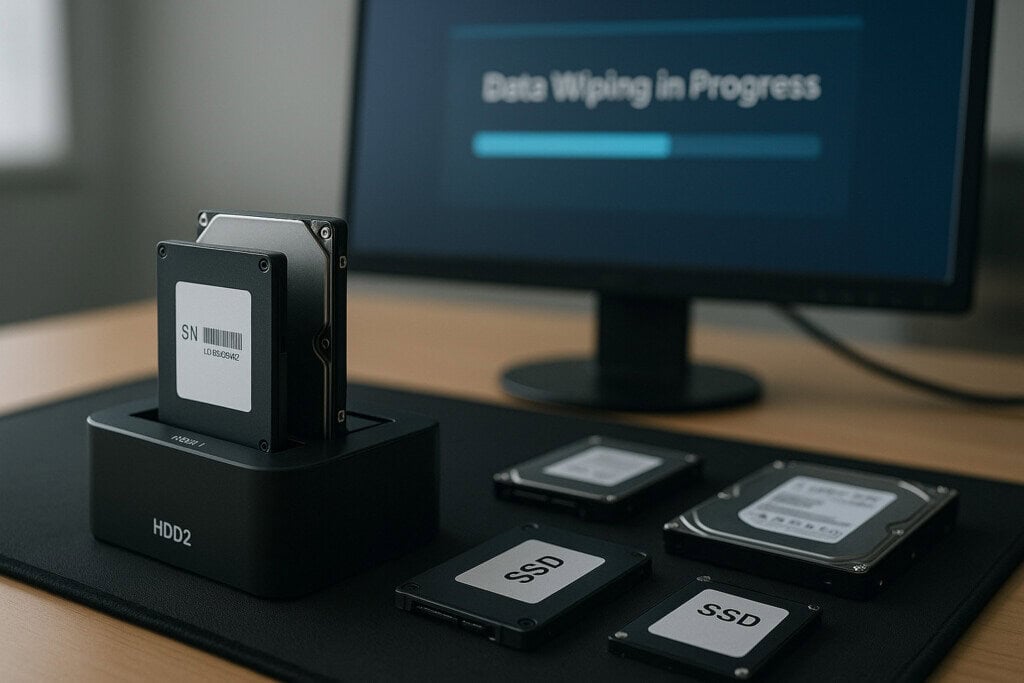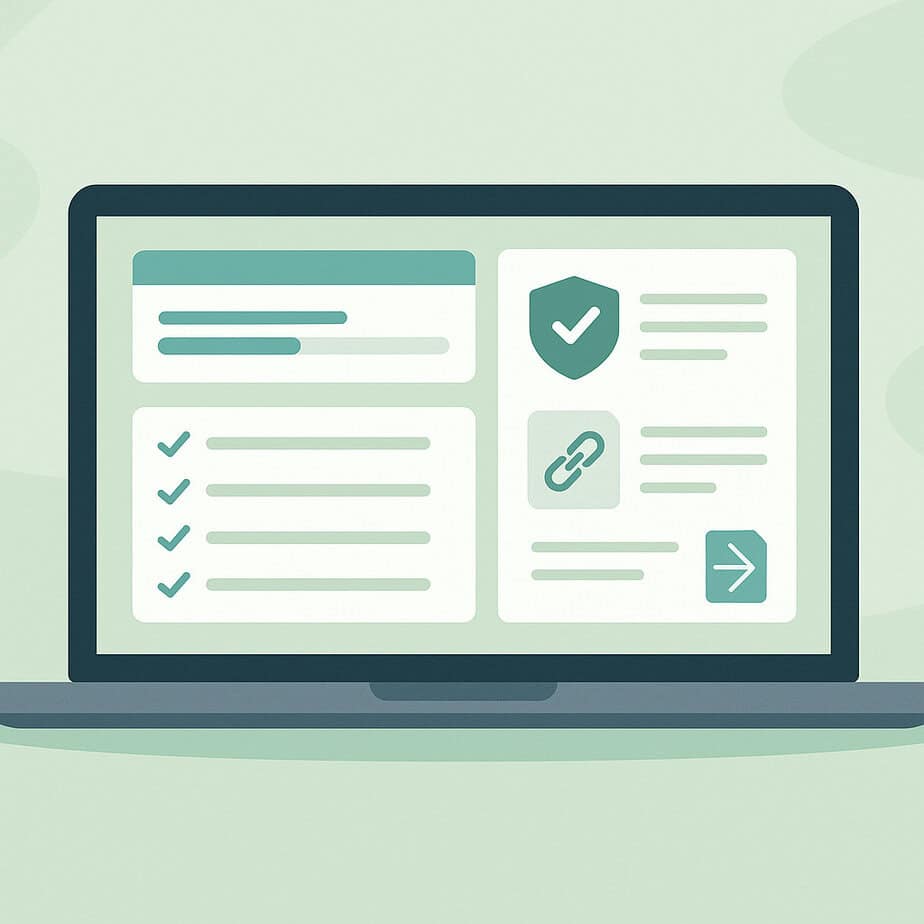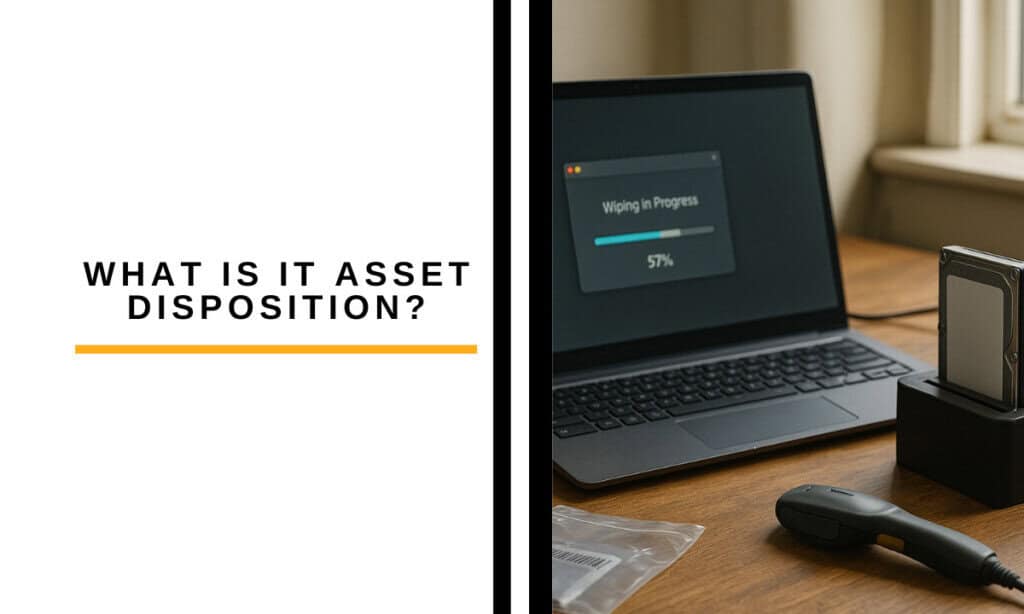Last Updated on September 21, 2025 by Ewen Finser
If you run a digital-first business — whether it’s SaaS, e-commerce, a digital agency, publishing, or managed IT — you already know how fast technology moves. Servers, laptops, storage arrays, and networking gear that felt cutting-edge just a few years ago are suddenly slowing you down or costing more to maintain than they’re worth.
That’s where IT Asset Disposition (ITAD) comes in.
In plain English, ITAD is the process of safely retiring, reselling, recycling, or disposing of your old IT hardware. It’s not just an “IT department task” anymore. For digital business leaders, it’s a strategic play that directly impacts:
- Data security (keeping sensitive client or customer info safe)
- Regulatory compliance (avoiding fines under GDPR, HIPAA, SOX, etc.)
- Cost recovery (getting real money back through hardware resale)
- Sustainability & ESG (meeting environmental commitments clients and investors care about)
Done well, ITAD protects your brand, preserves client trust, and even puts dollars back into your growth budget. Done poorly, it opens you up to data breaches, lawsuits, downtime, and wasted value.
And that’s why every digital business — especially those scaling fast — needs a clear, repeatable ITAD framework.
You might also be interested in: The Best ITAD Companies for Secure and Sustainable Asset Disposition
TL;DR
If you don’t have time to read this whole guide, here’s the bottom line:
- ITAD = Secure, compliant, and profitable hardware retirement.
- Expect costs to range from $50–$200 per server and $25–$75 per laptop/desktop depending on services.
- Data sanitization (software wiping or physical destruction) adds $10–$75 per drive.
- On the flip side, resale can recover 20–50% of original hardware value — turning a cost into revenue.
- Risks of skipping ITAD: data breaches, compliance fines, client trust loss, wasted hardware value, ESG penalties.
- To maximize ROI, work with a certified, trusted ITAD partner.
Now let’s break it down step by step.
What Is IT Asset Disposition (ITAD)?
Think of ITAD as a structured process for what happens when your hardware reaches the end of its useful life. It’s the opposite of procurement — you’re not buying gear, you’re retiring it.
But it’s not as simple as throwing a server in the recycling bin or listing it on eBay. ITAD is about secure, compliant, and financially smart decommissioning.
At its core, ITAD usually involves:
- Assessment & Planning → inventory, objectives, budgeting
- Data Sanitization → secure data erasure or destruction
- Hardware Removal → physical extraction with chain-of-custody tracking
- Asset Resale vs. Recycling → recover value or ensure responsible disposal
- Logistics & Chain of Custody → secure movement, traceability, compliance
- Compliance Reporting → certificates, audit-ready documentation
- Ongoing Governance → making ITAD repeatable, not ad-hoc
Every enterprise does this slightly differently, but the structure is always the same: protect data, recover value, and comply with regulations.
Why ITAD Matters for Digital Businesses
For digital businesses, ITAD isn’t just about cleaning out old gear. It directly ties into business-critical goals:
- Protecting Security & Client Trust
A single overlooked drive could contain millions of customer records. Breaches here aren’t just expensive — they’re reputationally devastating. Think lawsuits, churn, and PR nightmares. - Meeting Compliance Requirements
SaaS handling healthcare data? You’re under HIPAA. E-commerce selling globally? GDPR and CCPA apply. Auditors will ask for proof of secure data destruction. No certificate, no compliance. - Recovering Costs During Growth or Downsizing
That rack of old Dell servers might still fetch 30–50% of its original value if tested, wiped, and sold through the right channels. That recovered capital can fund your cloud migration, new hires, or even marketing campaigns. - Avoiding Downtime During Change Events
ITAD often coincides with M&A, cloud migrations, or office moves. If it’s mishandled, downtime costs you revenue. A structured ITAD process prevents that. - Demonstrating ESG Commitments
Clients and investors increasingly ask: “What are you doing about sustainability?” Proper ITAD ensures hardware is recycled responsibly and contributes to your ESG reporting.
For leadership, ITAD is no longer “just IT’s problem.” It’s a boardroom issue.
The Step-by-Step ITAD Framework
Now that we’ve defined ITAD and why it matters, let’s walk through the seven steps every digital business leader should follow when retiring IT assets. Think of this as a checklist you can run on repeat whenever you refresh infrastructure, downsize, or migrate to the cloud.

Step 1: Assessment & Planning
This is where you build the foundation. You need to know:
- What assets you have (inventory of servers, laptops, networking gear, storage, etc.)
- Where they live (on-prem, colocation, multiple offices, remote teams)
- Who owns them (leased vs. purchased equipment)
- What regulations apply (GDPR, HIPAA, SOX, PCI-DSS, etc.)
A good assessment sets expectations for cost, timeline, and ROI.
Costs:
- Internal inventory audits may take staff time only.
- Third-party site surveys can range from $1,500–$5,000 depending on scope.
ROI Potential:
- Identifying 10–20% of assets still carrying resale value can turn an expense into a cost-neutral — or even profitable — project.
Risk if Skipped:
- Missing assets = missed liabilities. An overlooked storage array could contain years of customer payment data.
Practical Cost Scenarios
People often underestimate how ITAD costs stack up against the risks of doing nothing. For example, securely decommissioning 50 servers at an average of $150 each may cost around $7,500. At first glance, this might feel like an unnecessary expense. But compare that with the potential financial hit from a single data breach — regulatory fines alone can reach six figures, not including client loss or reputation damage.
On the other end of the spectrum, reselling those 50 servers could recover $20,000–$40,000 depending on market demand, which not only offsets costs but turns ITAD into a positive cash flow event. By seeing ITAD as a risk-mitigation and cost-recovery exercise rather than a sunk cost, digital businesses put themselves in a much stronger financial position.
Step 2: Data Sanitization
This is the non-negotiable step. Every drive, SSD, or tape must either be securely wiped or physically destroyed.

Methods include:
- Software wiping (DoD 5220.22-M or NIST 800-88 compliant)
- Degaussing (for magnetic media)
- Shredding/crushing (for drives beyond reuse)
Costs:
- $10–$30 per drive for software erasure.
- $20–$75 per drive for shredding or degaussing.
ROI Potential:
- Drives that are wiped (not shredded) can often be resold, sometimes for $50–$300 each depending on capacity.
Risk if Skipped:
- Data breach fines can reach $250,000+ per incident under HIPAA or GDPR.
- Even a single leaked client database can erode trust beyond repair.
Step 3: Hardware Removal
Once drives are sanitized, equipment needs to be removed from racks, offices, or remote endpoints. This step is about safe handling, asset tagging, and chain of custody.
Costs:
- Onsite removal averages $50–$200 per server.
- Full rack decommissioning can range from $1,000–$5,000+.
ROI Potential:
- Recovered hardware can be resold in bulk (e.g., 10 Dell R740 servers may still fetch $1,500–$2,500 each on secondary markets).
Risk if Skipped:
- Improper handling = damaged equipment = lost resale value.
- Missing chain of custody = zero proof of compliance.
Step 4: Asset Resale vs. Recycling
Here’s where strategy comes in. Do you:
- Resell equipment still in demand?
- Recycle hardware past resale value?
- Donate certain assets for tax write-offs?
A strong ITAD partner will guide you through this decision, maximizing recovery value while staying compliant with e-waste laws.

Costs:
- Recycling-only programs may charge $0.10–$0.25 per pound.
- Resale-oriented ITAD providers often waive removal fees if resale offsets them.
ROI Potential:
- Expect 20–50% of original asset value back on enterprise servers, storage, and networking gear.
- Even laptops with dead batteries can fetch $50–$150 when wiped and resold.
Risk if Skipped:
- Throwing gear away = throwing money away.
- Non-compliant recycling can lead to environmental fines and ESG damage.
Step 5: Logistics & Chain of Custody
Whether equipment is resold or recycled, it must be tracked securely from your location to its final destination.
This includes:
- Sealed transport containers
- GPS-tracked vehicles
- Serialized asset tags
- Audit logs
Costs:
- Local pickups can cost $500–$2,000.
- Multi-site or international logistics can reach $10,000+.
ROI Potential:
- If resale offsets logistics, net cost can be zero or negative (meaning you get paid).
Risk if Skipped:
- Untracked assets = unaccounted liabilities. If hardware disappears in transit, you’re still on the hook for the data.
Step 6: Compliance Reporting
Every ITAD project should end with documentation you can show auditors, clients, or regulators. This usually includes:
- Certificates of data destruction
- Recycling compliance records
- Detailed chain-of-custody logs

Costs:
- Usually included in ITAD service packages.
- Premium reporting portals may add $500–$2,000 annually.
ROI Potential:
- Audit-ready documentation = avoided fines.
- Can also strengthen RFP responses by demonstrating compliance and sustainability practices.
Risk if Skipped:
- “No certificate = no proof.” In the eyes of regulators, it’s like the wipe never happened.
Step 7: Ongoing Governance
ITAD shouldn’t be an ad-hoc, once-in-a-while project. Digital-first businesses should build it into IT lifecycle governance.
That means:
- Scheduling ITAD alongside hardware refresh cycles
- Budgeting resale revenue into financial forecasts
- Including ITAD proof in ESG and compliance reports
- Training staff on chain-of-custody best practices
Costs:
- Minimal, if built into existing IT and compliance workflows.
ROI Potential:
- Long-term ITAD programs can save 10–15% annually on IT lifecycle costs by ensuring value recovery is maximized every time.
Risk if Skipped:
- Treating ITAD as an afterthought leads to higher costs, wasted value, and greater exposure to compliance risk.
Choosing the Right ITAD Partner
By now, you see that ITAD isn’t just an operational task — it’s a business-critical process. The right partner can make the difference between recovering thousands of dollars and losing money on top of compliance headaches.
So what should enterprise and digital-first leaders look for?
Key Qualities of a Reliable ITAD Partner
- Certifications: Look for R2v3, ISO 9001, ISO 14001, and ISO 45001. These signal industry-standard processes for quality, sustainability, and worker safety.
- Data Security First: Do they follow NIST 800-88 and DoD wipe standards? Do they provide certificates of destruction?
- Global Resale Network: The bigger their buyer network, the more they can pay you for assets.
- Transparent Reporting: Audit logs, chain-of-custody records, and compliance certificates should be standard.
- Sustainability Practices: Do they responsibly recycle? Can they support your ESG reporting goals?
Alta Technologies isn’t the only ITAD vendor out there, but they’re a good benchmark of what “good” looks like:
- 30+ years in business (rare longevity in this space).
- R2v3 and ISO certified — the gold standard in ITAD.
- Engineering-led testing means assets aren’t just dumped, they’re carefully evaluated for maximum resale.
- Global resale channels = more money back in your pocket.
- Logistics handled in-house so you’re not stuck coordinating a patchwork of subcontractors.
That said, I always recommend vetting multiple providers. Some may specialize in high-volume corporate refreshes, others in data center decommissioning, and others in SME-scale projects.
Pro tip: Always ask vendors for case studies from businesses similar in size and industry to yours.
The Leadership Case for ITAD
At first glance, ITAD feels tactical — something your IT team handles after a hardware refresh. But for digital-first companies, this is a C-level conversation. Here’s why:
1. Protecting Client Trust
If you run SaaS, e-commerce, or managed services, your entire reputation rests on how you handle customer data. A single mishandled server drive can undo years of brand equity.
2. Regulatory Compliance
ITAD reporting doubles as insurance in an audit. Whether it’s HIPAA, GDPR, or PCI-DSS, having certificates in hand means you pass faster and with fewer questions.
3. Cost Recovery During Growth or Downsizing
- Growth: During a data center refresh, selling your old gear can fund 10–20% of your new infrastructure.
- Downsizing: If you’re consolidating offices or remote endpoints, resale offsets removal and logistics costs.
4. Avoiding Disruption in M&A or Cloud Migrations
Investors and acquirers expect to see secure IT lifecycle practices. Unaccounted assets or missing destruction certificates can stall deals.
5. ESG Commitments
More investors and enterprise clients want proof of sustainability. ITAD partners with R2v3 certifications help tick the ESG box while keeping you compliant with e-waste laws.
ESG and Client Perception
For digital-first companies, ITAD is not just about compliance — it’s about reputation. Increasingly, enterprise clients and even consumers want to work with businesses that act responsibly across the entire lifecycle of their technology. Proper ITAD practices show that a company is serious about reducing e-waste, minimizing environmental harm, and protecting data integrity.
This aligns with ESG (Environmental, Social, and Governance) reporting frameworks, which investors and enterprise partners increasingly scrutinize. Highlighting responsible ITAD in client pitches or sustainability reports can create a competitive advantage, especially in industries where client trust is fragile. By responsibly recycling and reselling retired equipment, you demonstrate operational maturity while reinforcing your brand as both secure and sustainable.
Quick Leadership Checklist

If you remember nothing else from this guide, here’s the executive TL;DR for ITAD:
- Always start with an inventory assessment
- Treat data sanitization as a hard stop, not optional
- Don’t skip resale opportunities — they offset costs
- Insist on chain-of-custody tracking
- Make compliance auditable, not assumed
- Choose partners with certifications, experience, and resale reach
Done right, ITAD transforms from a cost center into a cost recovery engine.
Building ITAD into Business Strategy
One of the most overlooked benefits of ITAD is its role in long-term business planning. For companies scaling quickly, hardware refresh cycles can be unpredictable. By making ITAD a built-in process, not just an afterthought, companies can forecast costs, resale revenue, and replacement timelines with far greater accuracy.
This makes budgeting cleaner, improves financial predictability, and helps IT leaders present IT decisions to executives in terms of ROI rather than cost alone. Over time, a repeatable ITAD program becomes a strategic asset, giving companies better visibility into asset performance, lifecycle trends, and the true total cost of ownership. With this intelligence, leadership can make sharper decisions on whether to expand cloud infrastructure, reinvest in physical hardware, or pursue hybrid models that maximize both flexibility and cost efficiency.
Bottom Line
For enterprise and digital-first businesses, ITAD is bigger than old hardware. It’s about client trust, compliance, ESG credibility, and dollars back in your budget.
And while there are plenty of vendors in this space, my advice is simple: set a high bar. Look for certifications, transparency, and resale networks that give you maximum return.
That’s why companies like Alta Technologies stand out — they combine decades of expertise with certified processes and resale-driven models. But don’t take my word for it — test the market, ask for reports, and treat ITAD as the leadership-level priority it really is.

